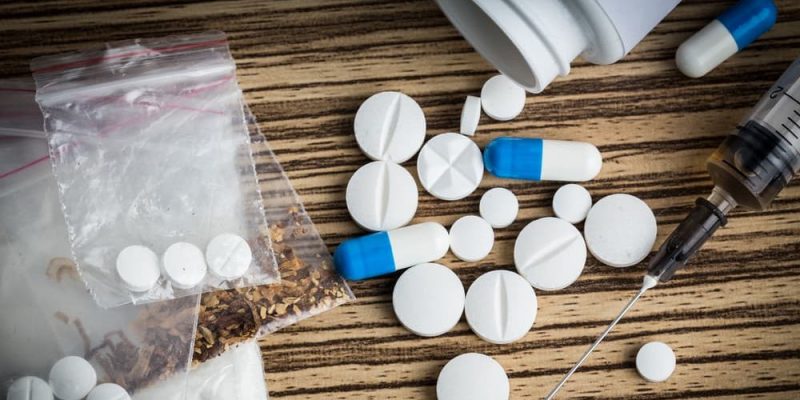We explain what drug addiction is, its history and how drugs are classified. Also, what are its characteristics, causes and consequences.
What is drug addiction?
Drug addiction, drug dependence or drug dependence is called pathological dependence on stimulating or altering substances of the central nervous system, capable of inducing hallucinations and altered states of consciousness, affecting judgment, emotions and the senses.
These substances, known as drugs or psychotropics, can be of natural or synthetic origin and are mostly prohibited by law .
Drug addiction is a global public health phenomenon that has repercussions on other social problems such as crime, school dropouts, prostitution and suicide.
It is considered that child and adolescent populations are most vulnerable to this phenomenon, because they lack the structures of judgment and maturity necessary to protect themselves.
There are cases of addiction to legal drugs , such as drugs and medications , but in particular synthetic, chemical drugs are feared, designed to generate a very high effect of dependence and enslave through their consumption the individual who, in order to consume, is capable of sacrificing material, moral and affective elements that in other conditions would be indispensable.
History of drug addiction

Addiction to psychoactive substances has accompanied man since ancient times , since they have often played an important role in ritual and magical acts (such as shamanic ones) to induce individuals to a "heightened" state of consciousness.
Substances such as alcohol, tobacco or cocaine have been present in civilization since time immemorial , as well as the prohibitions or limitations of their consumption, given the harmful effect (social, physical, psychological) that they can have on the individuals who consume them in excessively or constantly.
Classification of drugs

Drugs can be substances of different origin: synthetic (created in the laboratory) or natural (derived from plants , animals and fungi ), but they have in common a distorting effect on emotions and sensations, which can range from lucid dreams, sensations of pleasure and euphoria, up to hallucinations of varying degrees.
Drugs are usually classified according to their effect on the body, as follows:
- Stimulants: Those substances that produce a "high" or effect of hyperactivity or enlargement on the emotions and energy levels of the individual.
- Hallucinogens: They induce erroneous, mysterious or unreal perceptions in the senses of the individual, allowing him to see what is not there or even to experience lucid dreams.
- Depressants: Those that rather calm and numb the individual, decreasing their bodily activity and inducing relaxation.
- Hard drugs: Those whose dependency effect is immediate and intense, such as heroin.
- Soft drugs: Those whose dependency effect is milder and requires prolonged use to make them a habit.
Diagnosis of drug addiction
 According to specialists in the psychiatric area (DSM-IV-TR and ICD-10), certain consumption and behavioral traits must be met in individuals in order for them to be considered drug addicts. Simply submit three of the following in a rolling 12-month period:
According to specialists in the psychiatric area (DSM-IV-TR and ICD-10), certain consumption and behavioral traits must be met in individuals in order for them to be considered drug addicts. Simply submit three of the following in a rolling 12-month period:
- Increased tolerance to the substance. This has less and less effect and you must consume more amount to feel the same effect.
- Abstinence syndrome. When you stop using the substance for a long time, the individual becomes distressed, feels physically unwell, or despairs at more or less uncontrollable levels.
- Uncontrol of consumption. The substance is consumed in larger amounts or for much longer than was initially desired.
- Suffering from consumption. The use of the substance occurs despite knowing its harmful effects on the life (social, physical, emotional) of the individual, and often accompanied by an intense (but ineffective) desire to control or stop consumption.
- Obsession to consume. The individual progressively abandons all other interests that do not have to do with the consumption of the substance.
Stages of drug addiction
Usually three stages are identified in the drug addiction cycle, which feed back and generate more and more psychological and physical damage:
- Anguish to consume. The individual feels a strong desire to consume and even physical discomfort from not doing it on time. This is also known as “ craving ” (to crave , to desire very intensely).
- Uncontrolled consumption. The substance is finally consumed despite the individual's own reserves and at the cost (moral, economic, social) that it means.
- Culpability. Consumption generates a feeling of guilt once the euphoric or well-being segment passes, and the individual promises not to consume more or not to consume in the same way, a promise that cannot be fulfilled once the craving begins .
Overdose
 Given that the continuous exposure to drugs is attenuating their effect on the individual, he tends to increase the dose to be able to feel the same and thus approaches the mortal limit of consumption more and more, being able to expose himself to a higher dose than his own. body (often weakened by addiction) can bear.
Given that the continuous exposure to drugs is attenuating their effect on the individual, he tends to increase the dose to be able to feel the same and thus approaches the mortal limit of consumption more and more, being able to expose himself to a higher dose than his own. body (often weakened by addiction) can bear.
Consequences of drug addiction
The consequences of drug addiction are devastating for the individual and for their social and family environment, and include:
- Inability to lead a normal life. Eventually the drug takes over the life of the consumer, who begins to sacrifice more and more things to have it: he pays more and more money (and often loses the normal ability to generate it), sells personal items, etc.
- Physical and psychological damage. Beyond the emotional damage that the cycle of guilt and despair that destroys their life produces in the individual, uncontrolled consumption can lead to physical damage (contagion of diseases, malnutrition due to lack of appetite) or even neuronal damage .
- Isolation. Given the destructiveness of the cycle, drug addicts tend to isolate themselves and be rejected by their emotional environments: partners, family and friends, who may be victims of their needs.
- Death. Due to overdose, derived complications or street violence, since the addict usually operates in illicit environments.
Causes of drug addiction
Much of the world's population uses soft drugs completely recreationally and at moderate risks . But other people may take refuge in drugs to avoid difficult situations in their personal lives, such as trauma, loss, or chronic feelings of discomfort.
Legal drug addictions
 There is also the possibility of becoming addicted to substances of legal consumption , such as alcohol, cigarettes, sleeping pills, even coffee .
There is also the possibility of becoming addicted to substances of legal consumption , such as alcohol, cigarettes, sleeping pills, even coffee .However, as they are controlled by law (and despite the fact that many cost the lives of not a few people a year), their consumption is tolerated and even openly encouraged in the consumer society.
Drug addiction prevention
To prevent drug addiction, especially in vulnerable populations, it is necessary to inform and educate appropriately about them and without taboos , as well as to form personal values and vital passions that serve as a counterweight to the seductiveness of drugs. It is also essential to have addiction treatment and care agencies that serve both to recover addicts and to deter potential users .
Main drugs consumed
 The most widely used drugs in the world are marijuana ( cannabis ), cocaine in its various forms (powder, stones or “ crack ”) , heroin, ecstasy (pills), alcohol, tobacco and anxiolytics (sleeping pills ).
The most widely used drugs in the world are marijuana ( cannabis ), cocaine in its various forms (powder, stones or “ crack ”) , heroin, ecstasy (pills), alcohol, tobacco and anxiolytics (sleeping pills ).The above content published at Collaborative Research Group is for informational and educational purposes only and has been developed by referring reliable sources and recommendations from technology experts. We do not have any contact with official entities nor do we intend to replace the information that they emit.
MA student of the TransAtlantic Masters program at UNC-Chapel Hill. Political Science with a focus on European Studies. Expressed ideas are open to revision. He not only covers Technical articles but also has skills in the fields of SEO, graphics, web development and coding. .
Leave a reply
Your email address will not be published. Required fields are marked *Recent post

Sport: What Is It, Types, Risks, Features, Characteristics and Examples

Dogs: Emergence, Features, Characteristics, Feeding and Breeds

Story: Definition, Elements, Structure, Features and Characteristics

